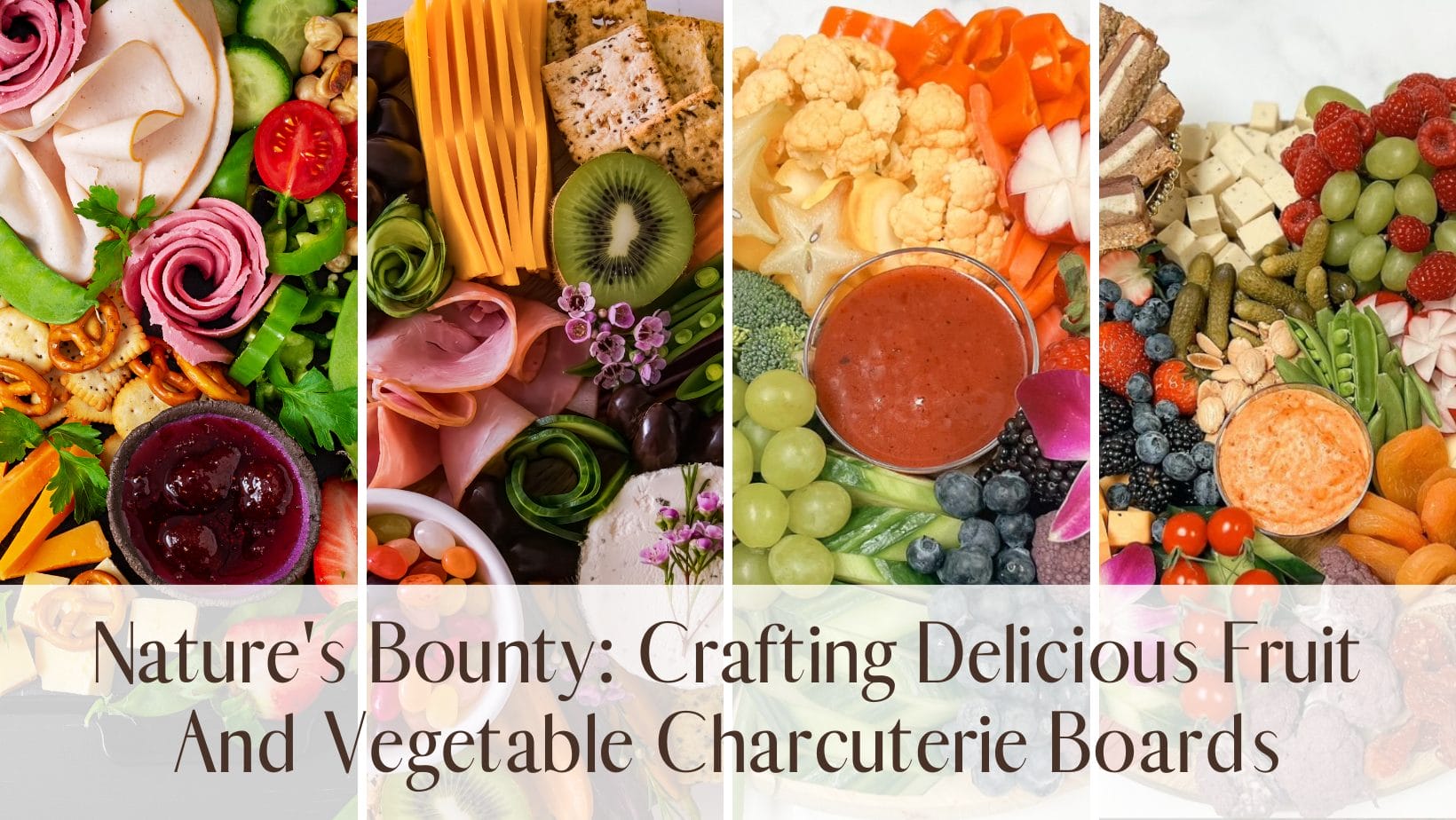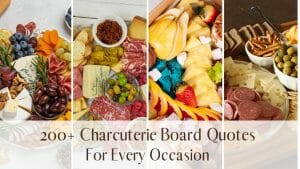In the realm of culinary delights, charcuterie boards have long reigned supreme as a symbol of elegance and taste. Traditionally adorned with cured meats and an assortment of cheeses, these boards have evolved beyond their origins to embrace a vibrant and health-conscious twist. Enter the fruit and vegetable charcuterie board—a celebration of nature’s bounty that tantalizes the palate with colors, textures, and flavors.
Gone are the days when charcuterie boards were solely reserved for carnivores and cheese aficionados. Today, these boards invite a broader spectrum of ingredients, placing a spotlight on the crispness of fresh vegetables, the juiciness of ripe fruits, and the artistry of presentation. Whether as a centerpiece for gatherings or a solo indulgence, a well-crafted fruit and vegetable charcuterie board promises to captivate both the eye and the taste buds.
TIP: Learn charcuterie fast from the best. Gain insights from a half-million strong community and impress at your next event. Click to join us >>
Table of Contents [CLICK HERE TO OPEN]
- What is a Fruit and Vegetable Charcuterie Board?
- Types of Fruit and Vegetable Charcuterie Boards
- Essential Ingredients for Your Board
- Designing Your Charcuterie Masterpiece
- Occasions and Themes for Your Board
- Health Benefits of Fruit and Vegetable Charcuterie
- Recipes and Creative Ideas
- Tools, Accessories, and Serving Tips
- Conclusion
- Frequently Asked Questions
What is a Fruit and Vegetable Charcuterie Board?
A fruit and vegetable charcuterie board is a visually appealing display of fresh produce, typically arranged on a wooden board or platter. While traditional charcuterie boards traditionally feature cured meats and cheeses, modern interpretations incorporate a variety of colorful fruits and vegetables. This evolution reflects a growing preference for healthier, plant-based options in culinary trends, catering to those seeking lighter, fresher alternatives without compromising on flavor or presentation.
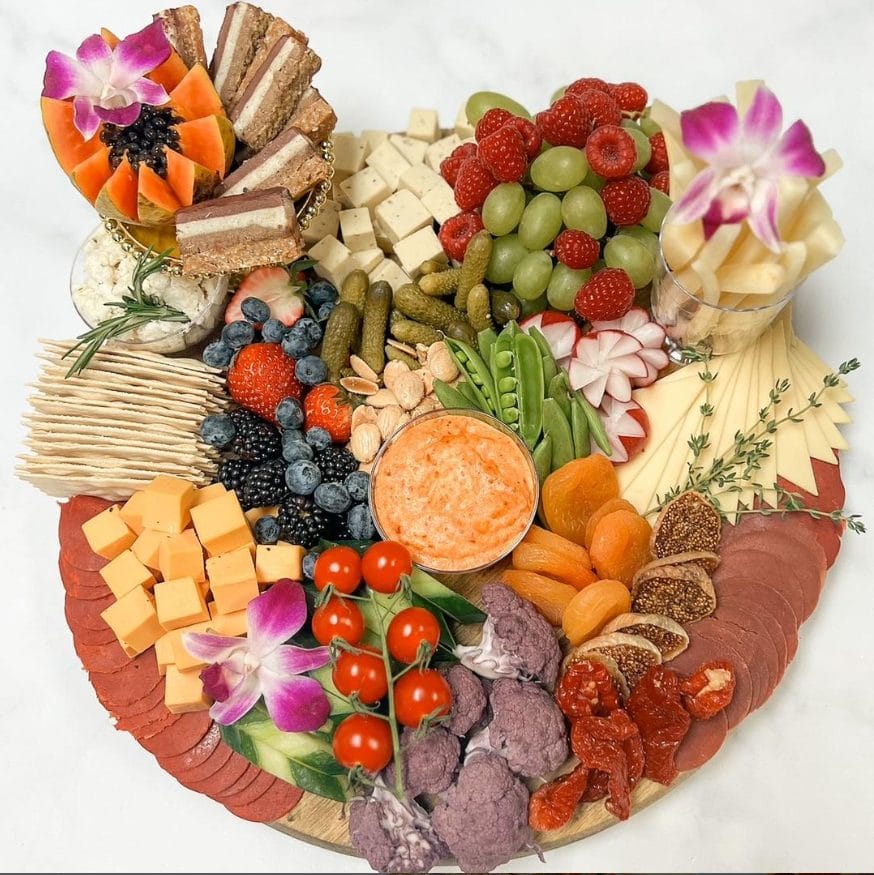
Types of Fruit and Vegetable Charcuterie Boards
- Fruit-only boards: These boards focus exclusively on a variety of fresh fruits, such as succulent berries, juicy melons, crisp apples, refreshing citrus, and exotic tropical fruits. They often include a selection of dried fruits like apricots, figs, or dates, as well as fruit preserves or fruit-infused honey to add layers of sweetness and texture.
- Vegetable-only boards: Vegetable charcuterie boards showcase an assortment of raw and cooked vegetables, artfully arranged to highlight their natural colors and textures. Popular choices include vibrant bell peppers, crunchy snap peas, tender asparagus spears, colorful cherry tomatoes, and roasted root vegetables like sweet potatoes or beets. These boards are typically accompanied by a variety of flavorful dips such as hummus, tzatziki, or roasted red pepper dip, offering a satisfying combination of flavors and textures.
- Mixed boards: Combining sweet and savory elements, mixed fruit and vegetable charcuterie boards offer a delightful balance of flavors and textures. These boards often feature a variety of cheeses ranging from creamy brie to sharp cheddar, complemented by an assortment of nuts such as almonds, walnuts, or pistachios. They may also include savory elements like olives, pickles, or antipasti alongside fresh fruits and vegetables, creating a diverse and appealing spread that caters to a variety of tastes.
Essential Ingredients for Your Board
Choosing the right ingredients is essential to creating a balanced and visually appealing fruit and vegetable charcuterie board that will impress your guests.
- Best fruits for charcuterie: Selecting fruits that are in season ensures optimal flavor and freshness. For example, strawberries and raspberries are perfect for spring and summer boards, while apples and pears offer a crisp sweetness ideal for fall and winter. Citrus fruits like oranges or grapefruits add a zesty brightness year-round.
- Recommended vegetables and dips: Incorporate a mix of crunchy and tender vegetables to provide a variety of textures and flavors. Carrot sticks, cucumber slices, radishes, and celery are excellent choices for their freshness and crunch. Pair these vegetables with creamy dips such as ranch, spinach-artichoke dip, or a tangy yogurt-based dip flavored with herbs or garlic for a satisfying contrast.
- Adding cheeses and nuts: Cheese selection plays a crucial role in enhancing the flavor profile of your charcuterie board. Opt for a variety of cheeses such as soft, creamy cheeses like brie or camembert, semi-hard cheeses like gouda or manchego, and bold-flavored cheeses like blue cheese or aged cheddar. Arrange them alongside an assortment of nuts such as almonds, walnuts, pecans, or pistachios to add a delightful crunch and additional depth of flavor to your board.
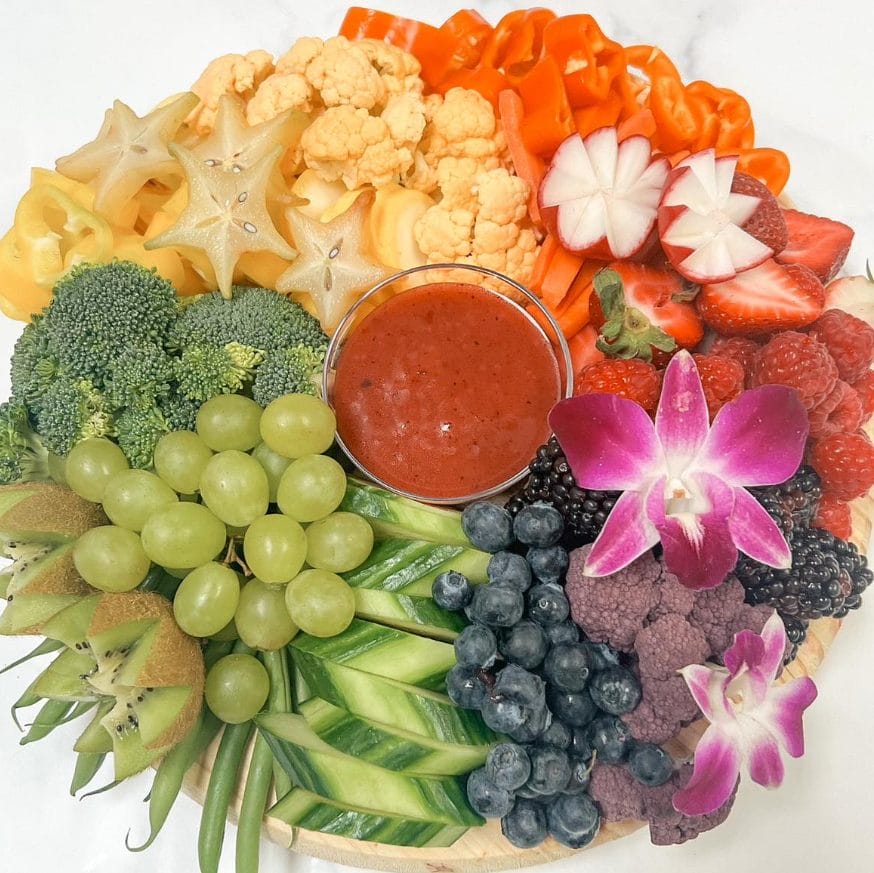
Designing Your Charcuterie Masterpiece
Designing a visually stunning fruit and vegetable charcuterie board requires careful consideration of colors, textures, and arrangement.
- Color palette and textures: Choose a color palette that complements the overall theme or season of your board. Incorporate a variety of vibrant colors such as reds, oranges, greens, and purples to create visual interest and appeal. Consider the textures of the ingredients as well, alternating between crunchy vegetables, smooth cheeses, and juicy fruits to create a dynamic and inviting presentation.
- Arrangement tips: Arrange your ingredients in a balanced and aesthetically pleasing manner. Start by placing larger items such as cheeses or bowls of dips strategically around the board to create focal points. Fill in the gaps with smaller items like nuts, berries, or small bunches of herbs to ensure every inch of the board is visually appealing. Experiment with different shapes and heights to add dimension and depth to your presentation.
- Garnishes and finishing touches: Garnish your charcuterie board with fresh herbs like basil or thyme, edible flowers such as nasturtiums or pansies, or citrus zest to add a final flourish of color and flavor. These finishing touches not only enhance the visual appeal of your board but also provide additional layers of aroma and taste, making your creation truly memorable.
Occasions and Themes for Your Board
Tailoring your fruit and vegetable charcuterie board to suit different occasions and themes can elevate the experience for your guests.
- Summer-themed boards: Embrace the vibrant colors and flavors of summer with fresh fruits like berries, watermelon, and stone fruits paired with light, refreshing dips. Add a touch of tropical flair with coconut or pineapple accents for a taste of paradise.
- Fall-inspired boards: Celebrate the harvest season with autumnal flavors such as apples, pears, figs, and pumpkin. Incorporate warm spices like cinnamon or nutmeg into dips or cheese pairings to evoke cozy fall vibes. Use seasonal decorations like mini pumpkins or colorful leaves to enhance the festive ambiance.
- Holiday and festive boards: Create a festive charcuterie board that reflects the spirit of the holidays with seasonal ingredients and themed decorations. Incorporate traditional holiday flavors like cranberries, pomegranates, and figs alongside rich cheeses and savory accompaniments. Decorate with festive garnishes like rosemary sprigs shaped into mini wreaths or edible gold dust for an elegant touch.

Health Benefits of Fruit and Vegetable Charcuterie
In addition to their visual appeal and flavor diversity, fruit and vegetable charcuterie boards offer numerous health benefits that appeal to health-conscious individuals.
- Nutritional advantages: Fresh fruits and vegetables are rich in essential vitamins, minerals, and antioxidants that support overall health and well-being. They provide a source of dietary fiber, which aids in digestion and promotes satiety. Incorporating a variety of colorful fruits and vegetables ensures a diverse range of nutrients that contribute to a balanced diet.
- Plant-based eating trends: The rise of plant-based eating has led to increased interest in fruit and vegetable charcuterie boards as a delicious and satisfying alternative to traditional meat and cheese platters. These boards cater to individuals following vegetarian, vegan, or flexitarian diets by offering a wide selection of plant-based ingredients that are both nutritious and flavorful.
- Incorporating nuts and seeds: Nuts such as almonds, walnuts, and pistachios add protein, healthy fats, and crunch to fruit and vegetable charcuterie boards. They provide a satisfying texture and enhance the flavor profile of the board while offering additional nutritional benefits. Choose unsalted or lightly salted nuts to control sodium intake and emphasize their natural flavors.

Recipes and Creative Ideas
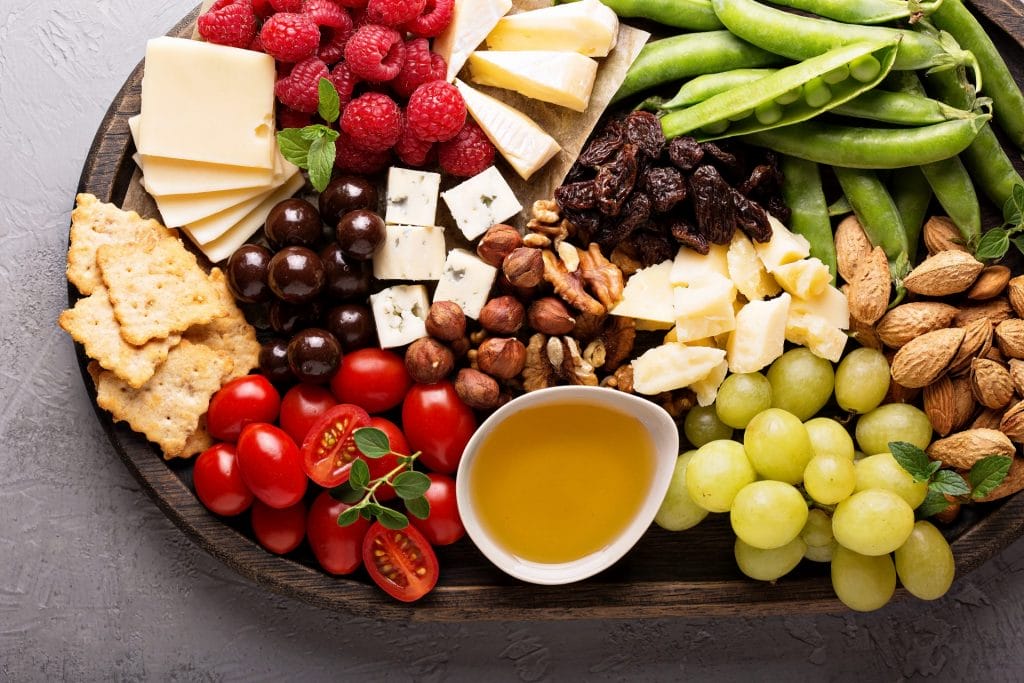
Recipes and Creative Ideas for Fruit and Vegetable Charcuterie Boards
Creating a fruit and vegetable charcuterie board is an opportunity to blend flavors, textures, and colors into a visually appealing and delicious spread. Here are some recipes and creative ideas to inspire your next board:
1. Seasonal Freshness
Summer Board:
- Fruits: Watermelon slices, pineapple chunks, strawberries, blueberries, and mango.
- Vegetables: Cucumber rounds, cherry tomatoes, baby carrots, bell pepper strips, and sugar snap peas.
- Accents: Fresh mint leaves, edible flowers, and a side of honey-lime yogurt dip.
Autumn Board:
- Fruits: Sliced apples, pears, grapes, pomegranate seeds, and figs.
- Vegetables: Roasted butternut squash cubes, radish slices, brussels sprouts (halved and roasted), and kale chips.
- Accents: Dried cranberries, walnuts, and a maple-tahini dipping sauce.
2. Themed Boards
Mediterranean Board:
- Fruits: Grapes, figs, and orange slices.
- Vegetables: Cucumber spears, cherry tomatoes, olives, and marinated artichoke hearts.
- Accents: Hummus, tzatziki, feta cheese crumbles, and fresh basil.
Tropical Board:
- Fruits: Mango slices, pineapple chunks, kiwi, passion fruit halves, and dragon fruit.
- Vegetables: Cucumber ribbons, bell pepper slices, and jicama sticks.
- Accents: Coconut flakes, macadamia nuts, and a spicy mango salsa.
3. Dips and Spreads
Incorporate a variety of dips and spreads to enhance the flavors of your fruits and vegetables:
- Fruit Dips: Greek yogurt with honey and cinnamon, chocolate fondue, or coconut cream with lime zest.
- Vegetable Dips: Classic hummus, avocado-lime dip, roasted red pepper dip, or cashew cream.
4. Creative Presentations
- Skewers and Picks: Create mini skewers with alternating pieces of fruit and cheese, or vegetables and olives, for easy grab-and-go options.
- Edible Cups: Hollow out bell peppers, small pumpkins, or even cabbage heads to use as containers for dips.
- Layering: Use a tiered serving tray to add dimension and variety, placing heartier vegetables on the bottom and delicate fruits on top.
5. Garnishes and Finishing Touches
- Herbs and Edible Flowers: Sprinkle fresh herbs like mint, basil, or rosemary, and decorate with edible flowers such as nasturtiums or pansies for a pop of color.
- Crunch and Texture: Add roasted nuts, seeds, or even crispy chickpeas for a satisfying crunch.
- Sweet and Savory Mix: Combine dried fruits like apricots or dates with savory elements such as cheese cubes or pickles to balance flavors.
By incorporating these recipes and creative ideas, you can design a fruit and vegetable charcuterie board that is not only nutritious but also a feast for the eyes and the taste buds. Whether for a casual family gathering or an elegant party, these boards are sure to impress and delight.
Tools, Accessories, and Serving Tips
Equipping yourself with the right tools and accessories is essential for preparing and serving your fruit and vegetable charcuterie board with ease and elegance.
- Essential tools: Invest in quality cutting boards, knives, and serving utensils designed for slicing fruits, vegetables, and cheeses. Choose knives with sharp blades and ergonomic handles for precise cutting and easy handling of ingredients.
- Serving dishes and boards: Select serving dishes and boards that complement the size and style of your charcuterie board. Opt for wooden boards, slate trays, or ceramic platters that provide a sturdy and attractive base for arranging your ingredients. Consider using individual bowls or ramekins for dips, nuts, or olives to keep them separate and prevent flavors from mingling.
- Knife selection and cutting techniques: Use different types of knives for cutting fruits, vegetables, cheeses, and nuts to ensure clean, uniform slices. For fruits like melons or pineapples, use a sharp chef's knife or serrated knife to remove the skin and cut into even wedges or cubes. When slicing cheeses, use a cheese knife with a specialized blade that prevents sticking and ensures smooth cutting. Practice safe cutting techniques by keeping your fingers away from the blade and using a cutting board to protect surfaces and prevent slips.
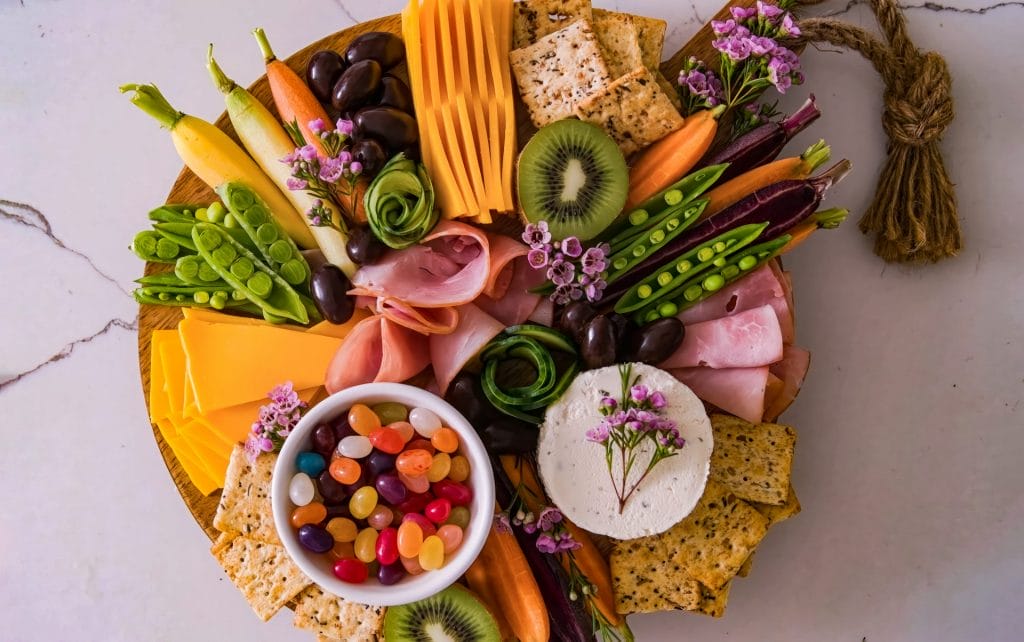
Conclusion
In conclusion, creating a stunning fruit and vegetable charcuterie board is not just about arranging ingredients—it's about curating an experience that delights the senses and brings people together. Whether you're hosting a casual gathering or a formal event, the versatility and creativity of fruit and vegetable charcuterie boards offer endless opportunities to showcase your culinary skills and impress your guests.
Frequently Asked Questions
What is the 3-3-3 rule for charcuterie board?
The 3-3-3 rule for a charcuterie board suggests including three types of cheeses, three types of meats, and three types of accompaniments, such as fruits, nuts, and spreads. This rule helps create a balanced and visually appealing spread with a variety of flavors and textures.
How to make a fruit and vegetable charcuterie board?
To make a fruit and vegetable charcuterie board, start by selecting a variety of fresh fruits and vegetables. Arrange them on a board or platter, alternating colors and textures for visual appeal. Include dips like hummus or yogurt-based sauces. Add cheeses, nuts, and garnishes like herbs or edible flowers for a stunning presentation.
What are 5 things to avoid on a charcuterie board?
These are 5 things to avoid on a charcuterie board:
- Overcrowding: Avoid overcrowding the board with too many items, which can make it look messy and difficult to serve.
- Lack of Variety: Ensure a variety of flavors and textures by including different types of cheeses, meats, fruits, and nuts.
- Poor Quality Ingredients: Use fresh, high-quality ingredients to enhance the overall taste and presentation.
- Mismatched Flavors: Avoid pairing conflicting flavors that may not complement each other well.
- Improper Serving Temperature: Serve cheeses and meats at room temperature for optimal flavor; avoid serving items that are too cold or too warm.
What goes on a vegetable charcuterie board?
A vegetable charcuterie board typically includes a variety of raw and cooked vegetables, complemented by flavorful dips and accompaniments. Common vegetables include cherry tomatoes, cucumber slices, bell pepper strips, carrot sticks, radishes, and blanched asparagus. Pair these with dips such as hummus, tzatziki, or baba ganoush for added taste and texture.
Share Your Creations:
We’d love to see the charcuterie boards you create using our guide! Feel free to share your own creations in the comments or on social media, and tag us for a chance to be featured. And if you have any other ideas or tips for creating the perfect charcuterie board, we’d love to hear them.

